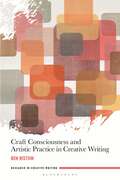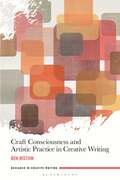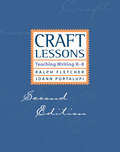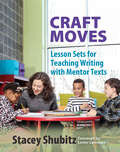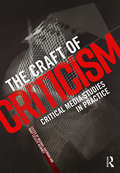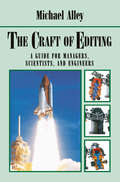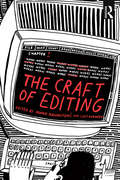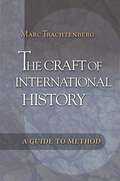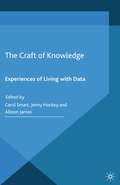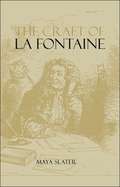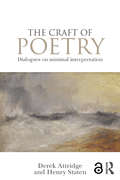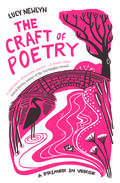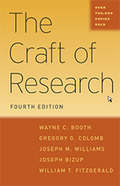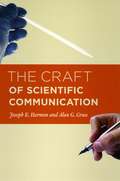- Table View
- List View
Craft Consciousness and Artistic Practice in Creative Writing (Research in Creative Writing)
by Ben RistowCraft lives inside the artist, and it operates in the mind, not in standards or techniques. Creative writers navigate thresholds in consciousness as they develop their arts practice. Craft Consciousness and Artistic Practice in Creative Writing explores what it is to be an artist as it traces radical, feminist, and culturally embedded traditions in craft. The new term "craft consciousness" identifies the nexus from which writers explore making processes and practitioner knowledge. Writers, as with all artists, create and reimagine themselves anew, and it is in this perpetual state of becoming that they find ways to enlarge their sense of artistry through an exploration of forms, processes, and mediums beyond the written word.For writers, this book initiates a reexamination of the mission of creative writing through disrupting patriarchal, racist, colonialist, ableist, and capitalist associations with dominant craft. Drawing from twenty-five interviews with living artists outside of writing and in a host of fields from conceptual art to leatherwork and dance, the book shines a light on how the processes associated with craft are embodied. Craft is an internalized matrix; it need not be commodified for the marketplace or codified in the standards necessitated by institutions of higher education. By redesigning writing workshops and MFA/PhD programs through craft consciousness, new potentials and collaborations emerge, and it becomes more conceivable to imagine dynamic, inclusive relationships between writers, scientists, and other artists.
Craft Consciousness and Artistic Practice in Creative Writing (Research in Creative Writing)
by Ben RistowCraft lives inside the artist, and it operates in the mind, not in standards or techniques. Creative writers navigate thresholds in consciousness as they develop their arts practice. Craft Consciousness and Artistic Practice in Creative Writing explores what it is to be an artist as it traces radical, feminist, and culturally embedded traditions in craft. The new term "craft consciousness" identifies the nexus from which writers explore making processes and practitioner knowledge. Writers, as with all artists, create and reimagine themselves anew, and it is in this perpetual state of becoming that they find ways to enlarge their sense of artistry through an exploration of forms, processes, and mediums beyond the written word.For writers, this book initiates a reexamination of the mission of creative writing through disrupting patriarchal, racist, colonialist, ableist, and capitalist associations with dominant craft. Drawing from twenty-five interviews with living artists outside of writing and in a host of fields from conceptual art to leatherwork and dance, the book shines a light on how the processes associated with craft are embodied. Craft is an internalized matrix; it need not be commodified for the marketplace or codified in the standards necessitated by institutions of higher education. By redesigning writing workshops and MFA/PhD programs through craft consciousness, new potentials and collaborations emerge, and it becomes more conceivable to imagine dynamic, inclusive relationships between writers, scientists, and other artists.
Craft Lessons: Teaching Writing K-8
by Ralph Fletcher JoAnn PortalupiSince its publication in 1998 Craft Lessons has become a staple in the writing classroom of both new and experienced teachers. Authors Ralph Fletcher and JoAnn Portalupi recognized the need for a succinct resource and teamed together to write the second edition of Craft Lessons: Teaching Writing K-8 . Teachers pressed for time will appreciate the practical lessons and instructional language geared to three grade level groupings: K-2, 3-4, and 5-8. This edition includes: 17 brand new lessons; mini lessons designed from teachers&’ comments about what is observed students&’ writing Revisions to other craft lessons and the resource materials sections have been expanded New ways to approach teaching using elements of craft and the reading-writing connection A subject index to find specific craft lessons with ease The authors&’ thoughts about how craft lessons fit into their newest thinking about the qualities of writing: Ideas, Design, Language, and Presentation The 95 lessons in this book provide a wealth of information for teaching leads, character, endings, stronger verbs, and much more. This new edition reestablishes Craft Lessons as the crucial desert island book for harried writing teachers everywhere
Craft Lessons: Teaching Writing K-8
by Ralph Fletcher JoAnn PortalupiSince its publication in 1998 Craft Lessons has become a staple in the writing classroom of both new and experienced teachers. Authors Ralph Fletcher and JoAnn Portalupi recognized the need for a succinct resource and teamed together to write the second edition of Craft Lessons: Teaching Writing K-8 . Teachers pressed for time will appreciate the practical lessons and instructional language geared to three grade level groupings: K-2, 3-4, and 5-8. This edition includes: 17 brand new lessons; mini lessons designed from teachers&’ comments about what is observed students&’ writing Revisions to other craft lessons and the resource materials sections have been expanded New ways to approach teaching using elements of craft and the reading-writing connection A subject index to find specific craft lessons with ease The authors&’ thoughts about how craft lessons fit into their newest thinking about the qualities of writing: Ideas, Design, Language, and Presentation The 95 lessons in this book provide a wealth of information for teaching leads, character, endings, stronger verbs, and much more. This new edition reestablishes Craft Lessons as the crucial desert island book for harried writing teachers everywhere
Craft Moves: Lesson Sets for Teaching Writing with Mentor Texts
by Stacey ShubitzHow do you choose mentor texts for your students? How do you mine them for the craft lessons you want your students to learn?In Craft Moves: Lesson Sets for Teaching Writing with Mentor Texts , Stacey Shubitz, co-founder of the Two Writing Teachers website, usestwenty recently published picture books to createmore than 180 lessons to teach various craft moves that will help your students become better writers.Each of the 184 lessons in the book includes a publisher's summary, a rationale or explanation of the craft move demonstrated in the book, and a procedure that takes teachers and students back into the mentor text to deepen their understanding of the selected craft move. A step-by-step guide demonstrates how to analyze a picture book for multiple craft moves.Shubitzintroduces picture books as teaching tools and offers ways to integrate them into your curriculum and classroom discussions. She then shares different routines and classroom procedures designed to help students focus on their writing during the writer's workshop as well as focusing how teachers can prepare for small group instruction.Using picture books as mentor texts will help your students not only read as writers and write with joy but also become writers who can effectively communicate meaning, structure their writing, write with detail, and give their writing their own unique voice.
Craft Moves: Lesson Sets for Teaching Writing with Mentor Texts
by Stacey ShubitzHow do you choose mentor texts for your students? How do you mine them for the craft lessons you want your students to learn?In Craft Moves: Lesson Sets for Teaching Writing with Mentor Texts , Stacey Shubitz, co-founder of the Two Writing Teachers website, usestwenty recently published picture books to createmore than 180 lessons to teach various craft moves that will help your students become better writers.Each of the 184 lessons in the book includes a publisher's summary, a rationale or explanation of the craft move demonstrated in the book, and a procedure that takes teachers and students back into the mentor text to deepen their understanding of the selected craft move. A step-by-step guide demonstrates how to analyze a picture book for multiple craft moves.Shubitzintroduces picture books as teaching tools and offers ways to integrate them into your curriculum and classroom discussions. She then shares different routines and classroom procedures designed to help students focus on their writing during the writer's workshop as well as focusing how teachers can prepare for small group instruction.Using picture books as mentor texts will help your students not only read as writers and write with joy but also become writers who can effectively communicate meaning, structure their writing, write with detail, and give their writing their own unique voice.
The Craft of Criticism: Critical Media Studies in Practice
by Michael Kackman Mary Celeste KearneyWith contributions from 30 leading media scholars, this collection provides a comprehensive overview of the main methodologies of critical media studies. Chapters address various methods of textual analysis, as well as reception studies, policy, production studies, and contextual, multi-method approaches, like intertextuality and cultural geography. Film and television are at the heart of the collection, which also addresses emergent technologies and new research tools in such areas as software studies, gaming, and digital humanities. Each chapter includes an intellectual history of a particular method or approach, a discussion of why and how it was used to study a particular medium or media, relevant examples of influential work in the area, and an in-depth review of a case study drawn from the author's own research. Together, the chapters in this collection give media critics a complete toolbox of essential critical media studies methodologies.
The Craft of Criticism: Critical Media Studies in Practice
by Mary Celeste Kearney Michael KackmanWith contributions from 30 leading media scholars, this collection provides a comprehensive overview of the main methodologies of critical media studies. Chapters address various methods of textual analysis, as well as reception studies, policy, production studies, and contextual, multi-method approaches, like intertextuality and cultural geography. Film and television are at the heart of the collection, which also addresses emergent technologies and new research tools in such areas as software studies, gaming, and digital humanities. Each chapter includes an intellectual history of a particular method or approach, a discussion of why and how it was used to study a particular medium or media, relevant examples of influential work in the area, and an in-depth review of a case study drawn from the author's own research. Together, the chapters in this collection give media critics a complete toolbox of essential critical media studies methodologies.
The Craft of Editing: A Guide for Managers, Scientists, and Engineers
by Michael AlleyDesigned for all those who deal with scientific and technical writing by others in universities, government labs, businesses, or engineering firms, this book helps readers become more effective and more efficient at editing the proposals, theses, journal articles, and reports that cross their desks and which need approving, grading, or reviewing. Written by the author of the best-selling "Craft of Scientific Writing", the guide deals with the subject in a refreshing way and includes a large number of enlightening examples and stories.
The Craft of Editing
by Adnan Mahmutović Lucy DurneenThe Craft of Editing offers a rare insight into the unique dynamic between author and editor. In this illuminating book, Adnan Mahmutović and Lucy Durneen lead a cohort of industry experts to bring transparency to the mystique that often surrounds the craft and practice of editing. Using genuine case studies from published works – including annotated manuscripts – this book prepares writers for potential dialogue and critique from editors. The Craft of Editing follows the journey from rough draft to publication, an essential part of any writing experience, while showing the singular and authentic approach each editor takes. Using original pitches, debates, emails, and instant messages to shed light on the collaboration between authors and editors, The Craft of Editing is an indispensable tool to creative writers and students alike.
The Craft of Editing
by Adnan Mahmutović Lucy DurneenThe Craft of Editing offers a rare insight into the unique dynamic between author and editor. In this illuminating book, Adnan Mahmutović and Lucy Durneen lead a cohort of industry experts to bring transparency to the mystique that often surrounds the craft and practice of editing. Using genuine case studies from published works – including annotated manuscripts – this book prepares writers for potential dialogue and critique from editors. The Craft of Editing follows the journey from rough draft to publication, an essential part of any writing experience, while showing the singular and authentic approach each editor takes. Using original pitches, debates, emails, and instant messages to shed light on the collaboration between authors and editors, The Craft of Editing is an indispensable tool to creative writers and students alike.
The Craft of International History: A Guide to Method
by Marc TrachtenbergThis is a practical guide to the historical study of international politics. The focus is on the nuts and bolts of historical research--that is, on how to use original sources, analyze and interpret historical works, and actually write a work of history. Two appendixes provide sources sure to be indispensable for anyone doing research in this area. The book does not simply lay down precepts. It presents examples drawn from the author's more than forty years' experience as a working historian. One important chapter, dealing with America's road to war in 1941, shows in unprecedented detail how an interpretation of a major historical issue can be developed. The aim throughout is to throw open the doors of the workshop so that young scholars, both historians and political scientists, can see the sort of thought processes the historian goes through before he or she puts anything on paper. Filled with valuable examples, this is a book anyone serious about conducting historical research will want to have on the bookshelf.
The Craft of International History: A Guide to Method
by Marc TrachtenbergThis is a practical guide to the historical study of international politics. The focus is on the nuts and bolts of historical research--that is, on how to use original sources, analyze and interpret historical works, and actually write a work of history. Two appendixes provide sources sure to be indispensable for anyone doing research in this area. The book does not simply lay down precepts. It presents examples drawn from the author's more than forty years' experience as a working historian. One important chapter, dealing with America's road to war in 1941, shows in unprecedented detail how an interpretation of a major historical issue can be developed. The aim throughout is to throw open the doors of the workshop so that young scholars, both historians and political scientists, can see the sort of thought processes the historian goes through before he or she puts anything on paper. Filled with valuable examples, this is a book anyone serious about conducting historical research will want to have on the bookshelf.
The Craft of Knowledge: Experiences of Living with Data
by Allison James Carol Smart Jenny HockeyThis book is a contribution to contemporary debates on social research with a unique focus on the relationship between methods and the crafting of knowledge. Nine experienced researchers from different disciplines have come together to explore what really matters to them in the process of doing qualitative research.
The Craft of LaFontaine
by Maya SlaterThis study provides a detailed account of the "Fables", including humour, the representation of animals, the literary qualities and the "moraliste" core. Dr Slater brings to light veiled satirical attacks, allusion to forgotten works and literature, and traces the obscure currents of thought, all this in the service of explicating the "fable" element.
The Craft of Poetry: Dialogues on Minimal Interpretation
by Derek Attridge Henry StatenThis book presents an innovative format for poetry criticism that its authors call "dialogical poetics." This approach shows that readings of poems, which in academic literary criticism often look like a product of settled knowledge, are in reality a continual negotiation between readers. But Derek Attridge and Henry Staten agree to rein in their own interpretive ingenuity and "minimally interpret" poems – reading them with careful regard for what the poem can be shown to actually say, in detail and as a whole, from opening to closure. Based on a series of emails, the book explores a number of topics in the reading of poetry, including historical and intellectual context, modernist difficulty, the role of criticism, and translation. This highly readable book will appeal to anyone who enjoys poetry, offering an inspiring resource for students whilst also mounting a challenge to some of the approaches to poetry currently widespread in the academy.
The Craft of Poetry: Dialogues on Minimal Interpretation
by Derek Attridge Henry StatenThis book presents an innovative format for poetry criticism that its authors call "dialogical poetics." This approach shows that readings of poems, which in academic literary criticism often look like a product of settled knowledge, are in reality a continual negotiation between readers. But Derek Attridge and Henry Staten agree to rein in their own interpretive ingenuity and "minimally interpret" poems – reading them with careful regard for what the poem can be shown to actually say, in detail and as a whole, from opening to closure. Based on a series of emails, the book explores a number of topics in the reading of poetry, including historical and intellectual context, modernist difficulty, the role of criticism, and translation. This highly readable book will appeal to anyone who enjoys poetry, offering an inspiring resource for students whilst also mounting a challenge to some of the approaches to poetry currently widespread in the academy.
The Craft of Poetry: A Primer in Verse
by Lucy NewlynA wonderfully accessible handbook to the art of writing and reading poetry—itself written entirely in verse How does poetry work? What should readers notice and look out for? Poet Lucy Newlyn demystifies the principles of the form, effortlessly illustrating key approaches and terms—all through her own original verse. Each poem exemplifies an aspect of poetic craft—but read together they suggest how poetry can evoke a whole community and its way of life in myriad ways. In a series of beautiful meditations, Newlyn guides the reader through key aspects of poetry, from sonnets and haiku to volta and synecdoche. Avoiding glosses and notes, her poems are allowed to speak for themselves, and show that there are no limits to what poetry can communicate. Newlyn’s timeless verse will appeal to lovers of poetry as well as to practitioners, teachers, and students of all ages.Onomatopoeia You’d play here all day if you had your way— near the stepping-stones, in the clearest of rock-pools, where water slaps and slips; where minnows dart, and a baby trout flop-flips.
The Craft of Research, Fifth Edition (Chicago Guides to Writing, Editing, and Publishing)
by Joseph M. Williams Wayne C. Booth Gregory G. Colomb Joseph Bizup William T. FitzGeraldA thoroughly updated edition of a beloved classic that has guided generations of researchers in conducting effective and meaningful research. With more than a million copies sold since its first publication, The Craft of Research has helped generations of researchers at every level—from high-school students and first-year undergraduates to advanced graduate students to researchers in business and government. Conceived by seasoned researchers and educators Wayne C. Booth, Gregory G. Colomb, and Joseph M. Williams, this fundamental work explains how to choose significant topics, pose genuine and productive questions, find and evaluate sources, build sound and compelling arguments, and convey those arguments effectively to others. While preserving the book’s proven approach to the research process, as well as its general structure and accessible voice, this new edition acknowledges the many ways research is conducted and communicated today. Thoroughly revised by Joseph Bizup and William T. FitzGerald, it recognizes that research may lead to a product other than a paper—or no product at all—and includes a new chapter about effective presentations. It features fresh examples from a variety of fields that will appeal to today’s students and other readers. It also accounts for new technologies used in research and offers basic guidelines for the appropriate use of generative AI. And it ends with an expanded chapter on ethics that addresses researchers’ broader obligations to their research communities and audiences as well as systemic questions about ethical research practices. This new edition will be welcomed by a new and more diverse generation of researchers.
The Craft of Research, Fourth Edition (Chicago Guides to Writing, Editing, and Publishing)
by Joseph M. Williams Wayne C. Booth Gregory G. Colomb Joseph Bizup William T. FitzGeraldWith more than three-quarters of a million copies sold since its first publication, The Craft of Research has helped generations of researchers at every level—from first-year undergraduates to advanced graduate students to research reporters in business and government—learn how to conduct effective and meaningful research. Conceived by seasoned researchers and educators Wayne C. Booth, Gregory G. Colomb, and Joseph M. Williams, this fundamental work explains how to find and evaluate sources, anticipate and respond to reader reservations, and integrate these pieces into an argument that stands up to reader critique. The fourth edition has been thoroughly but respectfully revised by Joseph Bizup and William T. FitzGerald. It retains the original five-part structure, as well as the sound advice of earlier editions, but reflects the way research and writing are taught and practiced today. Its chapters on finding and engaging sources now incorporate recent developments in library and Internet research, emphasizing new techniques made possible by online databases and search engines. Bizup and FitzGerald provide fresh examples and standardized terminology to clarify concepts like argument, warrant, and problem. Following the same guiding principle as earlier editions—that the skills of doing and reporting research are not just for elite students but for everyone—this new edition retains the accessible voice and direct approach that have made The Craft of Research a leader in the field of research reference. With updated examples and information on evaluation and using contemporary sources, this beloved classic is ready for the next generation of researchers.
The Craft of Scientific Communication (Chicago Guides to Writing, Editing, and Publishing)
by Joseph E. Harmon Alan G. GrossThe ability to communicate in print and person is essential to the life of a successful scientist. But since writing is often secondary in scientific education and teaching, there remains a significant need for guides that teach scientists how best to convey their research to general and professional audiences. The Craft of Scientific Communication will teach science students and scientists alike how to improve the clarity, cogency, and communicative power of their words and images. In this remarkable guide, Joseph E. Harmon and Alan G. Gross have combined their many years of experience in the art of science writing to analyze published examples of how the best scientists communicate. Organized topically with information on the structural elements and the style of scientific communications, each chapter draws on models of past successes and failures to show students and practitioners how best to negotiate the world of print, online publication, and oral presentation.
The Craft of Scientific Communication (Chicago Guides to Writing, Editing, and Publishing)
by Joseph E. Harmon Alan G. GrossThe ability to communicate in print and person is essential to the life of a successful scientist. But since writing is often secondary in scientific education and teaching, there remains a significant need for guides that teach scientists how best to convey their research to general and professional audiences. The Craft of Scientific Communication will teach science students and scientists alike how to improve the clarity, cogency, and communicative power of their words and images. In this remarkable guide, Joseph E. Harmon and Alan G. Gross have combined their many years of experience in the art of science writing to analyze published examples of how the best scientists communicate. Organized topically with information on the structural elements and the style of scientific communications, each chapter draws on models of past successes and failures to show students and practitioners how best to negotiate the world of print, online publication, and oral presentation.
The Craft of Scientific Communication (Chicago Guides to Writing, Editing, and Publishing)
by Joseph E. Harmon Alan G. GrossThe ability to communicate in print and person is essential to the life of a successful scientist. But since writing is often secondary in scientific education and teaching, there remains a significant need for guides that teach scientists how best to convey their research to general and professional audiences. The Craft of Scientific Communication will teach science students and scientists alike how to improve the clarity, cogency, and communicative power of their words and images. In this remarkable guide, Joseph E. Harmon and Alan G. Gross have combined their many years of experience in the art of science writing to analyze published examples of how the best scientists communicate. Organized topically with information on the structural elements and the style of scientific communications, each chapter draws on models of past successes and failures to show students and practitioners how best to negotiate the world of print, online publication, and oral presentation.
The Craft of Scientific Communication (Chicago Guides to Writing, Editing, and Publishing)
by Joseph E. Harmon Alan G. GrossThe ability to communicate in print and person is essential to the life of a successful scientist. But since writing is often secondary in scientific education and teaching, there remains a significant need for guides that teach scientists how best to convey their research to general and professional audiences. The Craft of Scientific Communication will teach science students and scientists alike how to improve the clarity, cogency, and communicative power of their words and images. In this remarkable guide, Joseph E. Harmon and Alan G. Gross have combined their many years of experience in the art of science writing to analyze published examples of how the best scientists communicate. Organized topically with information on the structural elements and the style of scientific communications, each chapter draws on models of past successes and failures to show students and practitioners how best to negotiate the world of print, online publication, and oral presentation.
The Craft of Scientific Communication (Chicago Guides to Writing, Editing, and Publishing)
by Joseph E. Harmon Alan G. GrossThe ability to communicate in print and person is essential to the life of a successful scientist. But since writing is often secondary in scientific education and teaching, there remains a significant need for guides that teach scientists how best to convey their research to general and professional audiences. The Craft of Scientific Communication will teach science students and scientists alike how to improve the clarity, cogency, and communicative power of their words and images. In this remarkable guide, Joseph E. Harmon and Alan G. Gross have combined their many years of experience in the art of science writing to analyze published examples of how the best scientists communicate. Organized topically with information on the structural elements and the style of scientific communications, each chapter draws on models of past successes and failures to show students and practitioners how best to negotiate the world of print, online publication, and oral presentation.
